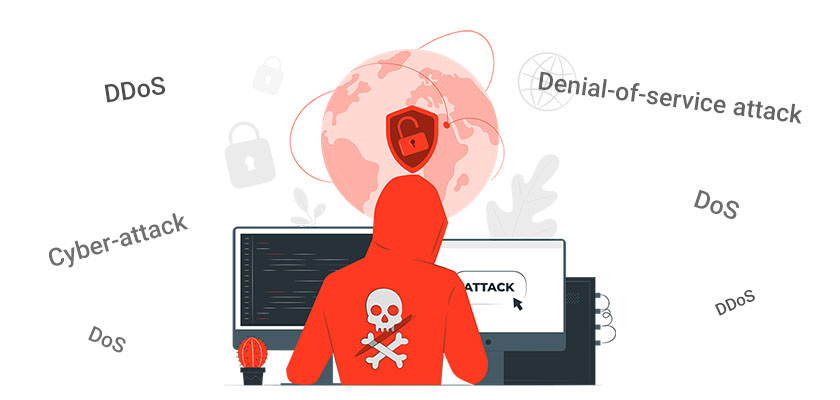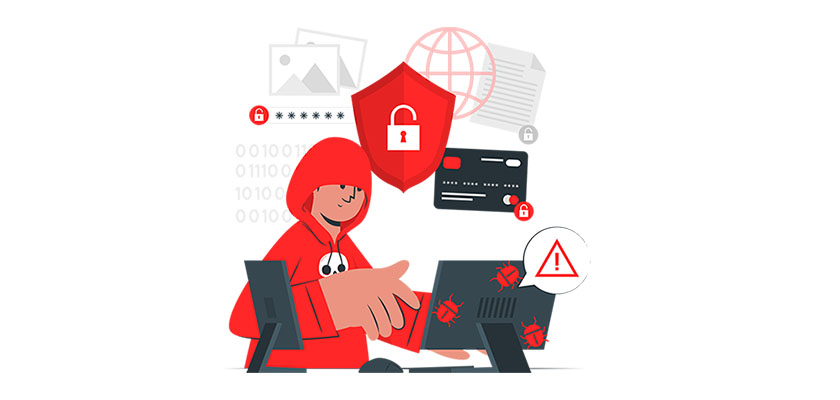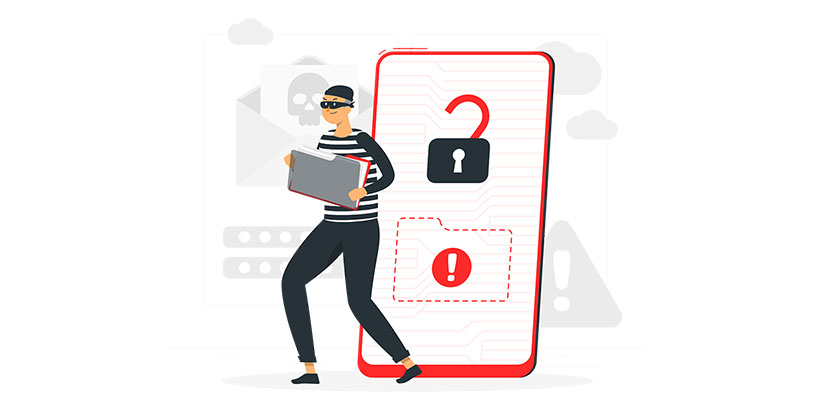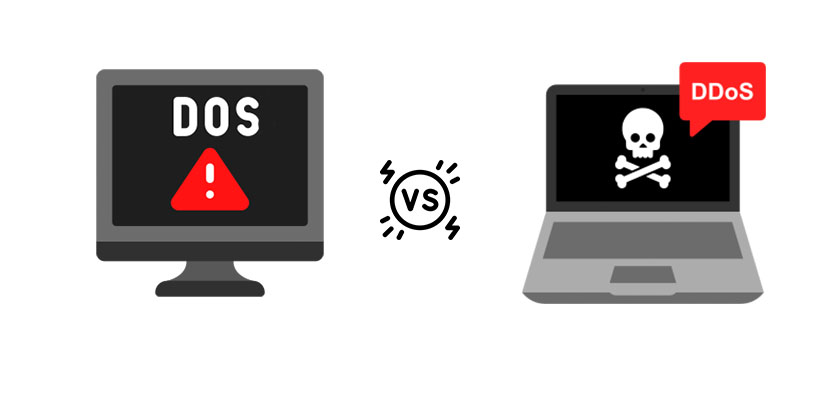
Although Denial of Service (DoS) and Distributed Denial of Service (DDoS) attacks share the same names and objectives, there’s an important difference between the two. The number of systems involved when a cyberattack is launched. One computer can start the DoS attack, whereas the botnet comprises several systems that will be required to execute the DDoS attack.
In this article, we’ll look at DoS vs. DDoS attacks.
What Is DoS?
DoS attack is designed to render a targeted system or application in a position to handle legitimate requests. This can range from reducing its performance to creating a complete crash. DoS attacks can occur in a variety of ways. For instance, an attacker could exploit a flaw in the application targeted, causing it to shut down. Because this causes the application to go offline, it’s an attack that is a DoS attack.
Another type of DoS attack is associated with one called a DDoS attack. In this attack, a perpetrator employs a computer to make hundreds of spam messages to a target server or application to overload it. Because the resources that the server or application targeted dedicated to handling spam messages are not used for legitimate requests, the system’s performance suffers.
Types of Denial-of-Service Attacks (DoS)

1. Application-layer Flood
In this kind of attack, the attacker floods it with requests coming from a spoofed IP address to slow or stop the service. It could take, for example, millions of requests per second or several thousand requests to a resource-intensive service, which consumes services until they are in a position to handle the requests.
The prevention of application layer DoS attacks can prove challenging. The most effective way to combat these attacks is outsourcing pattern detection and IP filters to a third party (discussed in a future article) or investing in a DDoS-protected VPS hosting.
2. Distributed Denial of Service Attacks (DDoS)
Distributed DoS (DDoS) attacks happen the same way, similar to DoS attacks, except that requests are made from multiple clients, as opposed to only one. DDoS attacks typically involve several “zombie” machines (previously compromised machines controlled by hackers). The “zombie” machines then send considerable requests to a server to shut it down.
DDoS attacks are known to be difficult to stop. However, a DDoS-protected VPS Hosting is your only chance to fight against these types of requests.
3. Unintended Denial of Service Attacks
There are many reasons why DoS attacks are malicious. The third attack is the “unintended” Denial of Service attack. The most famous instance of an unintentional DDoS is described as “The Slashdot Effect. Slashdot is an online news website that allows anyone to post news stories and links to other websites. If a story is linked and gets popular, it may result in millions of users browsing the site, thereby overloading it with requests. If the site isn’t designed to handle this demand, the increased traffic could cause a slowdown or crash the linked site. Reddit and “The Reddit Hug of Death” is another great example of an accidental DoS.
One way to stop these unintentional DoS attacks is to design your application to scale. Make use of patterns such as edge-caching, CDNs, HTTP caching headers, auto-scaling groups, and other strategies to ensure that your website will not be affected even if you experience a lot of traffic in bursts. And make sure you invest in the best DDoS-protected VPS.
Another kind of accidental DoS attack is when serving areas with low bandwidth. For example, global streaming content implies that users in specific regions of the world with poor or slow internet connections could cause issues. If your service tries to deliver information to low-bandwidth regions and packets are dropped, the service will experience a fall. To send the information to the destination, the service will attempt to send all lost packets. If the connection stops sending packets, the service could try again. This could make your service’s load triple or double, which can cause your service to become slow or inaccessible to everyone.
What Is DDoS?
The DDoS attack is a heightened version of the second type of attack. DoS attack. Instead of a single computer, the attacker can utilize a range of internet-connected devices to launch a coordinated attack on a target system. The bigger scale of these attacks increases the likelihood of bringing a system offline.
DDoS attacks are usually carried out with botnets or computer networks under the attacker’s control. Although botnets can be constructed with the help of cloud computing resources that are cheap, however, it is more usual for cybercriminals to build botnets using compromised systems that were compromised by their attacks.
They are usually made up of vulnerable and insecure internet-connected devices. For instance, Mirai built a botnet of 400,000 compromised devices at its highest level by logging into devices using one of sixty login passwords. Other botnets exploit weaknesses in devices that are not regularly updated and patched, such as routers and Internet of Things (IoT) devices.
Common DDoS attacks types

The most frequently utilized DDoS attacks are:
UDP Flood
The term “UDP flood” refers to a UDP flood, a DDoS attack that floods the victim using User Datagram Protocol (UDP) packets. The attacker aims to flood ports on the host. The host will constantly check for an application that is listening on the port and (when there is no such application) respond by sending an ICMP “Destination Unreachable packet. This is a drain on host resources and could ultimately result in inaccessibility.
ICMP (Ping) Flood
Like the UDP flood attack, an ICMP flood inundated the target resource by flooding it with ICMP Echo Request (ping) packets, typically sending out packets at the speed of light without waiting for responses. This attack may use up all incoming and outgoing bandwidth since the victim’s server will typically try to respond using ICMP Echo Reply packets, leading to a major system slowdown.
SYN Flood
The SYN flood DDoS attack exploits a vulnerability within the TCP connection sequence (the “three-way handshake”) in which the SYN request to establish the TCP connection to the host has to be followed by an SYN-ACK reply from the host, followed by the ACK reply from the user. In the case of an SYN flood attack, the user sends several SYN requests; however, they either do not reply to the host’s response or send the SYN requests using a fake IP address. In either case, the host system waits for an acknowledgment from each request and then binds resources until new connections can be established, resulting in a denial of service.
Ping of Death
A Ping of Death (“POD”) threat involves sending numerous malicious or malformed pings to computers. The maximum length for one IP packet (including header) is 65,535 bytes. However, the Data Link Layer usually limits frame size, for instance, 1500 bytes on one Ethernet network. In this instance, the large IP packet is split into several IP packets (known as fragments), and then the receiving host reassembles the IP fragments to form the entire packet. In the Ping Of Death situation, resulting from intentional manipulation of fragments, the victim receives an IP packet bigger than 65,535 bytes once reassembled. The memory buffers could be overloaded. That is allocated to the packet, which results in an interruption in service for legitimate packets.
Slowloris
Slowloris is a targeted attack that allows one server to shut off another one without impacting the other ports or services of the targeted network. Slowloris accomplishes this by keeping all connections to the targeted server open as long as possible. It establishes connections to the server and then sends one request. Slowloris continually sends additional HTTP headers; however, it never finishes a request. The server that is targeted keeps all of these fake connections open. This ultimately overflows the concurrent connection pool, which causes the server to block additional connections from authentic clients.
NTP Amplification
In NTP amplification attacks, the perpetrator exploits publically-accessible Network Time Protocol (NTP) servers to overwhelm a targeted server with UDP traffic. The attack is classified as an amplification attack since the ratio of query-to-response in these instances is anywhere from 1:20 to 1:200 or greater. That means that an attacker who has access to a list of accessible NTP servers (e.g., using a program like Metasploit or obtaining data downloaded from the Open NTP Project) could quickly launch a devastating high-bandwidth and high-volume DDoS attack.
HTTP Flood
When a DDoS attack is the case of an HTTP flood DDoS attack, an attacker exploits legitimate HTTP POST or GET requests to target a web server or an application. HTTP floods don’t use maliciously formatted packets, spoofing, or reflection techniques and use smaller bandwidth than most attacks that can bring down the targeted website or server. The most successful attack occurs when it can force the application or server to allocate the most resources available to each request.
Zero-day DDoS Attacks
“Zero-day” is a term used to describe vulnerabilities. “Zero-day” definition encompasses all new or undiscovered attacks that exploit vulnerabilities for which there’s no patch yet made available. Hackers widely use the term in the community, and trading in zero-day vulnerability has become a common practice.
DoS vs. DDoS Attack Differences

The primary distinction between DoS vs. DDoS difference is that one is a systems-on-system attack, whereas the latter involves multiple systems in a single attack. There are other distinctions, however, that are related to their nature or the method of detection, for example:
- Ease of detection/mitigation: Since a DoS comes from a single location, it is easier to detect its origin. A well-designed firewall can accomplish this. Contrarily the DDoS attack results from numerous remote locations, obscuring its source.
- The speed of attack is because DDoS attacks originate from multiple locations; DDoS attacks are derived from multiple places and can be launched more quickly than the DoS attack that comes from one location. The speed increase makes it harder to detect and can result in more damage or devastating consequences.
- The volume of traffic that is a DDoS attack uses several remote computers (zombies, also known as bots) and, as such, it can send larger volumes of traffic to various places simultaneously and overload servers without detection.
- The method of execution used in a DDoS attack coordinates several hosts infected by malware (bots) to create an automated botnet managed by a command-and-control (C&C) server. However, the case of a DoS attack generally employs a script or tool to execute the attack using one machine.
- Tracking the source(s) of a botnet’s use of botnets in a DDoS attack implies that tracking the source is more difficult than tracing the root of the DoS attack.
DoS vs. DDoS Attacks, Which Is More Deadly?
The first thing to note is that DoS and DDoS are both dangerous, as it’s hard to differentiate this type of attack from the rigors of traffic or connectivity problems. But, there are signs that an attack is ongoing, such as unnoticed slow performance of the network as well as a denial-of-service due to any of the digital properties or a mysterious interruption in network connectivity for devices connected to that same network. If you experience abrupt slowdown or performance issues simply, this could be caused by a DDoS attack.
Additionally, DDoS attacks are riskier than DoS attacks because the former attacks are carried out from multiple systems, whereas a single computer carries out the latter. This makes it more difficult for security professionals and teams to determine the source of the threat. If you have multiple points of origin, they must be identified and blocked to prevent an ongoing attack, making it more difficult to detect DDoS attacks and riskier.
It was previously thought impossible that a DDoS attack could surpass 1Tbps (Terabits per second). In September 2017, Google was hit by the threat of a 2.5 Tbps DDoS attack that shocked the world of DDoS. Today, thanks to the latest technological advances regarding cloud computing and Internet infrastructure, hackers have greater resources than ever before. This is why businesses should evaluate their exposure and risk to DDoS and consider DDoS protection solutions, such as investing in DDoS-protected VPS hosting.
Why Do DoS and DDoS Attacks Occur?
If it’s a DoS vs. DDoS attacks, there are numerous motives that an attacker might want to shut down the business. Let’s have a look at some of the more frequent reasons behind DDoS and DoS attacks being employed to harm businesses. The most common reasons include:
- Ransom: Perhaps, the most popular motive behind a DDoS attack is the need to demand an amount of ransom. Once the attack is successful, the attackers request a ransom to stop and get the network operational. It’s not recommended to pay these ransoms since there’s no guarantee that the business will return to being fully operational.
- Malicious Competitors: Malicious competitors seeking to shut an enterprise out of business could also be a motive to allow DDoS attacks. If a company’s network is taken down, competitors could attempt to steal customers away from your company. It is believed to be a common occurrence within the online gambling community, where rivals will attempt to block each other to gain an edge.
- Hacktivism: HTML0 hacktivism, in many instances, the motive behind an attack isn’t economical but rather personal or political. It’s not unusual for hackers to take the websites of governments or enterprises offline to signal their opposition. This could be for any reason an attacker considers significant, but usually, it is because of political motives.
- Posing a Problem: Many attackers are simply interested in causing trouble for private users and networks. It’s no secret that cybercriminals enjoy putting companies offline. For many hackers, DDoS attacks offer a method to fool individuals. Some view DDoS attacks as “victimless,” which is a shame considering the amount of money that successful attacks can cost a business.
- Disgruntled Employees: Another popular reason for cyberattacks is the discontent of former employees. If someone is unhappy with the company, a DDoS attack could effectively get revenge on you. Although most employees maturely manage grievances, some utilize these tactics to hurt an organization when they have personal problems.
Conclusion
In this article, we discussed DoS and DDoS differences. We explained them individually and mentioned a few types of each attacks that may occur or have occurred throughout the history of IoT. People and businesses may have reasons to attack one another, either to shut the business down or simply get revenge. DoS vs. DDoS attacks can simply ruin a business depending on the type of attack they have received. But generally speaking, you can recover from a DoS or DDoS attack. A VPS server with DDoS protection helps you keep safe from any cyber attack and protect your website’s data.










Leave a Reply